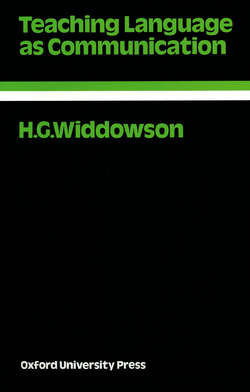Читать книгу Teaching Language as Communication - H. G. Widdowson - Страница 3
На сайте Литреса книга снята с продажи.
Introduction
ОглавлениеThis book is an attempt to clarify certain issues that seem to me to arise from adopting a communicative approach to the teaching of language. I have in mind, in particular, the teaching of English to speakers of other languages. Over recent years I (and a number of others) have advocated such an approach in principle and have tried to put it into practice in the preparation of teaching materials. In principle and practice, however, there always seemed to be loose ends of one sort or another: inconsistencies, unexamined assumptions, unresolved difficulties. My aim in this book was to sort out some of the things that I had been saying, consider their implications more closely, and see if they might be ordered into a coherent account. I wanted to try to think things through.
The ‘communicative’ approach is, of course, very much in vogue at present. As with all matters of fashion, the problem is that popular approbation tends to conceal the need for critical examination. There seems to be an assumption in some quarters, for example, that language is automatically taught as communication by the simple expedient of concentrating on ‘notions’ or ‘functions’ rather than on sentences. But people do not communicate by expressing isolated notions or fulfilling isolated functions any more than they do so by uttering isolated sentence patterns. We do not progress very far in our pedagogy by simply replacing abstract isolates of a linguistic kind by those of a cognitive or behavioural kind. If we are seriously interested in an approach to language teaching which will develop the ability to communicate, then we must accept the commitment to investigate the whole complex business of communication and the practical consequences of adopting it as a teaching aim. Such a commitment involves, I believe, a consideration of the nature of discourse and of the abilities that are engaged in creating it. This is the main concern of the first part of this book. The commitment involves, too, an attempt to think out the possible pedagogic procedures which will lead the learner towards the ability to handle discourse. The second part of the book represents such an attempt. I do not claim that in either part I have done any more than open up a number of possibilities. Our present state of knowledge about language and language learning is such that it would be irresponsible to be anything but tentative. But it would be even more irresponsible to avoid investigation and to pretend that there are no problems.
So this book is not in any way intended as propaganda for a new ‘communicative’ orthodoxy in language teaching. It is, on the contrary, an appeal for critical investigation into the bases of a belief and its practical implications. I am not trying to present a conclusive case but to start an inquiry.
There are, it seems to me, two ways of looking at publication. The first, which one might dub the classical view, regards appearance in print as the final public revelation of carefully rehearsed ideas made as definitive and as precise as possible. The aim is for universality and permanence and one proceeds towards publication with cautious circumspection. This classical view is the one expressed by Alexander Pope in his curt recommendation to other, and lesser, poets: ‘Keep your piece nine years!’ The other view, the romantic, is less concerned with completeness, is much less cautious and circumspect, and regards publication, more cavalierly perhaps, as a device for public speculation. The aim here is to stimulate interest by exposure, to suggest rather than to specify, to allow the public access to personal thinking. It is this second view that I subscribe to in publishing this book. I accept, therefore, that its contents are transitional and transient. They are meant as a personal consideration of issues that seem to me to stand in need of examination at the moment.
When I say that this book is personal, I do not want to imply that I have produced it in isolation from the ideas of others. Quite the reverse. Over the past eight years I have had the benefit of continuing discussions with the staff and students in the Department of Linguistics at Edinburgh and most of what is worthwhile in this book derives directly or indirectly from them. Now, as I am about to leave Edinburgh for London, I should like to express my sense of personal and professional debt to that department. I must make particular mention of Patrick Allen with whom I have worked in developing the English in Focus series, which has been, and continues to be, an attempt to produce practical teaching materials in accordance with the kind of approach I explore here. The authors of particular titles in the series – Eric Glendinning, Elizabeth Laird, Joan Maclean, Alan Mountford and Ian Pearson – have all made valuable contributions to this development and have given me ideas that I would not have thought of on my own. Other people whose influence I would particularly like to acknowledge are Tony Howatt, who was kind enough to read through an earlier draft of the book and made many valuable suggestions for improvement, Guy Aston, Christopher Candlin, Malcolm Coulthard, John Sinclair, Hugh Trappes-Lomax, Sandy Urquhart and David Wilkins. None of these people will agree with everything I say, of course; some might be quite appalled at the effect of their influence; all of them would very likely have made a better job of various parts of this book.
A different kind of influence altogether has been that of my wife. It is equally important, although I do not acknowledge it openly as often as I ought.
H. G. Widdowson
Edinburgh
March 1977
